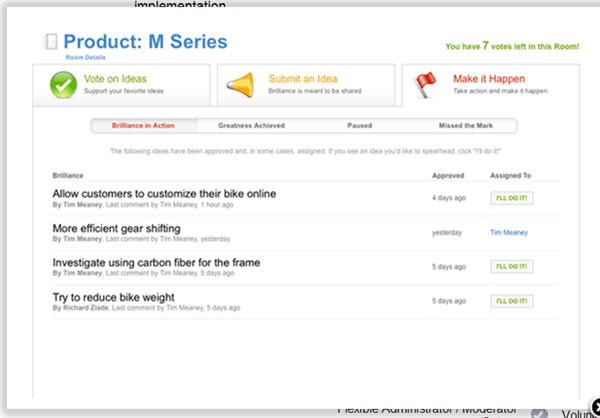
What is Innovation Management?
Now we could quote Wikipedia here, but the name seems to stand on its own. Organizations need to be constantly thinking of new ways to do things, to make their products, solutions and services stand out from the rest.
But it's not just a matter of sitting in a closed door meeting writing ideas on the whiteboard, then doing a round table hands up vote on the most favorite. Well, some organizations may do that, but we won't go there.
You need a place to create and manage these ideas. And to measure whether the ones you end up implementing are actually successful. And the truth is, there may be a lot of people in your organization who have some very good ideas, you just need to provide a way to get them talking.
And so innovation, or idea, management solutions exist to serve this need. CMSWire recently took some time to speak with Steve Girling, SVP of Sales & Business Development at Kindling, a provider of innovation management software, to learn more about how their solution helps organizations "promote and implement the best ideas."
From Tiny Roots Grow Big Ideas
It's funny how some solutions come into existence. We tend to think a team of people spend hours behind locked doors banging out detailed business plans. It doesn't always happen that way. Kindling started out as a weekend project by a developer who worked for the company.

Kindling: Idea Capture
The original concept was for a solution that would help capture ideas. But capturing ideas is only part of the process of innovation management and Kindling has grown over the last two years to support the entire process of managing and supporting innovation.
The Democratization of Innovation
As Girling points out, innovation has evolved into a core belief for organizations and the smart ones recognize that there are many people within their rank and file who can contribute good ideas.
It's this user engagement that Kindling has focused on: how to engage users who do not live within the Kindling environment all the time. Their development strategy is based on further collaboration which in turn furthers user engagement.
Success, Not Fancy Apps
Girling also noted that clients are looking for success, not fancy apps, which makes the user experience important. So what are some of the capabilities of this particular solution?
- Idea capture
- Idea Campaigns on a specific topic, with optional rewards or incentives to participate
- Tracking of approved ideas throughout the implementation process
- Reporting: ROI (estimated and actual), activity, campaign effectiveness, user participation

Kindling - Idea Implementation
Kindling is a SaaS application that, based on their client list alone, is scalable and secure. It can also be installed on-premise and it has an open API (PHP and SQL).
According to Girling, one of Kindling's differentiators is that they don't push the application integration story. Yes, their solution has an open API and can integrate with other business systems, but it's not something they sell as a first step. Kindling believes an organization needs to prove they can do innovation first before they get involved in an integration project.
The Competition for Ideas is Growing
There are a number of vendors who have idea, or innovation, management solutions:
- Imaginatik - the veteran
- BrightIdea - named as a potential acquisition target for Salesforce.com
- Spigit - who recently picked up a nice sum for funding
And of course we recently wrote about another similar solution called Xpoint from element8.
You may ask whether social software solutions can easily serve this need. Some would say yes, especially if they are called NewsGator or Jive Software. Both have modules for innovation management.
Whether you choose a standalone app or something integrated with your social software may depend on what you are trying to achieve. Perhaps the most important thing to look at isn't the software itself, but the expertise in idea management sitting behind it. Because your employees may have great ideas, but engaging them in the process tends to be the harder part.
